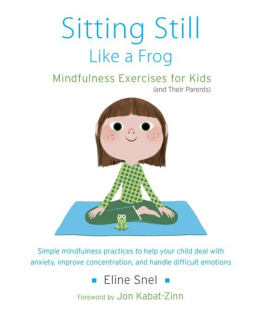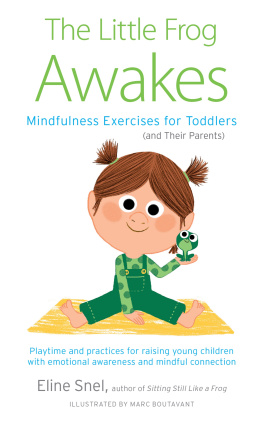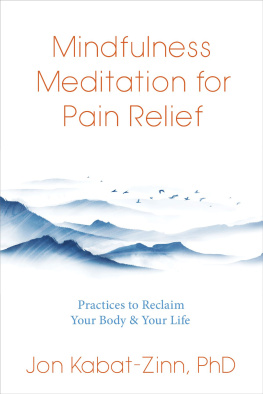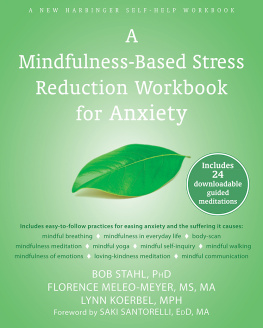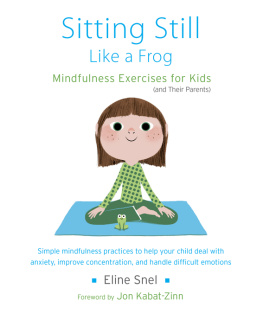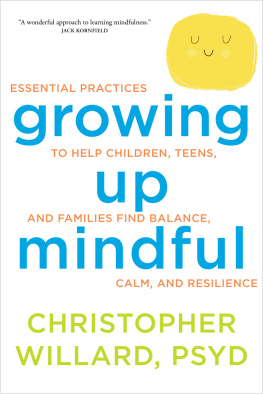Sitting Still Like a Frog introduces the basics of mindfulness to children in an easy-to-understand and playful way. It guides children in the cultivation of presence: presence of mind, presence of heart, and presence in the body. This is something we are all capable of but usually dont cultivate intentionally. Why not start young in training those capacities? The world nowadays is so complex and fast-paced that knowing how to ground oneself in the present moment is an absolute necessity to make sense of the world and to continue learning, growing, and contributing what is uniquely yours to contribute in this world.
from the foreword by Jon Kabat-Zinn
ABOUT THE BOOK
This introduction to mindfulness meditation for children and their parents includes practices that can help children calm down, become more focused, fall asleep more easily, alleviate worry, manage anger, and generally become more patient and aware.
ELINE SNEL is a therapist and certified MBSR trainer and runs the Academy for Mindful Teaching in the Netherlands. She has been developing and teaching mindfulness-based courses for over twenty years and trains teachers to teach MBSR techniques to students. Her program has been used in numerous primary schools in the Netherlands. She has recently started a pilot project in various secondary schools to teach mindfulness practices to teenagers.
Sign up to learn more about our books and receive special offers from Shambhala Publications.

Or visit us online to sign up at shambhala.com/eshambhala.


Shambhala Publications, Inc.
Horticultural Hall
300 Massachusetts Avenue
Boston, Massachusetts 02115
www.shambhala.com
2013 by Eline Snel
Cover art Marc Boutavant
Dutch edition 2010 Uitgeverij Ten Have
Stilzitten als een kikker: Mindfulness voor kinderen (512 jaar) en hun ouders was originally published in the Netherlands by Uitgeverij Ten Have
www.uitgeverijtenhave.nl
Illustrations: Mirjam Roest
All rights reserved. No part of this book may be reproduced in any form or by any means, electronic or mechanical, including photocopying, recording, or by any information storage and retrieval system, without permission in writing from the publisher.
Library of Congress Cataloging-in-Publication Data
Snel, Eline.
[Stilzitten als een kikker. English]
Sitting still like a frog: mindfulness exercises for kids (and their parents) / Eline Snel.First edition.
Pages cm
Translation of the authors Stilzitten als een kikker.
Includes bibliographical references.
eISBN 978-0-8348-2919-0
ISBN 978-1-61180-058-6 (pbk.: alk. paper)
1. Mind and body. 2. Awareness. 3. Child psychology. 4. Consciousness. I. Title.
BF161.S63613 2013
155.413dc23
2013004159
In order to love you need to be at home in yourself.
I would like to thank my husband, Henk, and our children, Hans, Anne Marlijn, Koen, and Rik, for their deeply felt need to love, accept, comfort, and motivate both themselves and others at every opportunity.
Contents
I first became aware of Sitting Still Like a Frog while browsing in a big bookstore in downtown Amsterdam in April 2011. It was pointed out to me by Joke Hellemanns, a Dutch Mindfulness-Based Stress Reduction teacher, who had already read it and loved it. A large stack of them was part of an even larger presentation of books on mindfulnesssomething that even a few years earlier would have been inconceivable in a mainstream bookstore anywhere. This prominent display was itself evidence that we are now living in a new era in which mindfulness training and practice are rapidly becoming an integral part of the landscape of life. Eline Snels book and her work with children in Holland are part of a much larger movement that has emerged over the past ten years, in many different countries, to bring mindfulness training into schools. My first impression of Elines book was that she was pioneering an approach that was straightforward, imaginative, and accessible to children.
The practice of mindfulness at any age is both simple and profound. Above all, it involves learning learning how to cultivate greater self-awareness and greater awareness of others and the world, and then reaping the substantial benefits of that awareness, both inwardly and outwardly. The specific applications of this learning are seemingly boundless. We do not know what specific knowledge our children are going to most need ten or twenty or even five years from now because the world and their work, when they come to it, will be so different from ours. What we do know is that they will need to know how to pay attention, how to focus and concentrate, how to listen and how to learn, and how to be in wise relationship with themselvesincluding their thoughts and emotionsand with others. As you will see, that skill set, this approach to learning and embodied knowing, lies at the heart of mindfulness.
Mindfulness is an innate capacity that is tapped, developed, and deepened through practice. It definitely involves cultivation , in the sense of planting and watering seeds and then tending those seeds as they first take root and grow in the soil of our hearts and then flower and bear fruit in interesting, useful, and creative ways. It all starts with attention and being present. When the roll is called each day, children respond by saying present. But sometimes it is only the body that is in the classroom all the same. Mindfulness is about learning to be fully present. This is exactly what this book and the guided mindfulness exercises (available at www.shambhala.com/sittingstilllikeafrog) are about.
Sitting Still Like a Frog introduces the basics of mindfulness to children in an easy-to-understand and playful way. It guides children in the cultivation of presence: presence of mind, presence of heart, and presence in the body. Presence comes when we are attentive, when we are in touch with our experience. And that quality of attentiveness is developed and deepened by paying attention to whatever is most salient and most important in each moment. This is something we are all capable of but usually dont cultivate intentionally. It requires focus and concentration. Why not start young in training those capacities? The world nowadays is so complex and fast-paced that knowing how to ground oneself in the present moment is an absolute necessity to make sense of the world and to continue learning, growing, and contributing what is uniquely yours to contribute in this world.
Although the cultivation of attention and awareness is called mindfulness , it is important to realize that it could equally well be called heartfulness because it is not merely about the head and cognition, but about our entire being and our multiple intelligences and ways of knowing and being, including the cultivation of kindness toward oneself and others. Whatever we call it, studies in both medicine and neuroscience are showing that mindfulness is an essential life skill that can have profound consequences in terms of both physical and mental health. It supports and enhances learning, emotional intelligence, and overall well-being across the lifespan. This book is an excellent way for parents to learn about mindfulness and share it with their children. One of my favorite exercises, among many, is Your Personal Weather Report.
Next page
